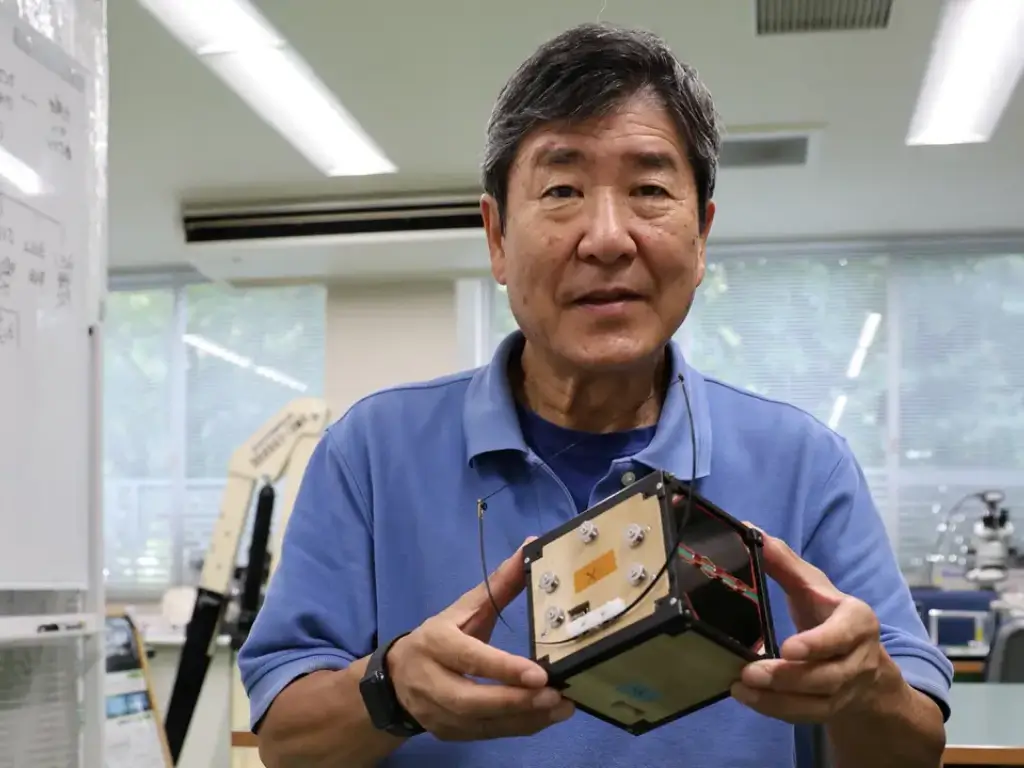Table of Contents
In a new inflection point for global sustainable tech and space advancement, Japan has sent the world’s first wooden satellite, called LignoSat, into orbit. LignoSat is the pioneering experiment officially launched by Kyoto University researchers with the help of the Japanese construction company Sumitomo Forestry to verify the possibility of using timber as a robust material in space conditions. Explore research and innovations at Kyoto University, including LignoSat’s development. This relatively minor, although quite scientific, satellite, launched by SpaceX, is part of a larger project to seek more environmentally friendly materials for future space travel and possibly colonization of the moon and Mars.
LignoSat has introduced a new type of renewable material into the aerospace industry, and there are high expectations that wood’s features will lead to green satellites and space construction. Again, different from metal-based classic satellites that release pollution when they burn up during their reentry into the earth’s atmosphere, the LignoSat, a wooden satellite, would burn up without creating any dangerous effects. It’s an early show of how the timber industry could support space sustainability and evolution.
Why Wood in Space?
After hammering, it may look a bit strange, but timber has some perks, especially in space, that is, if they wish to declare war. LignoSat’s wooden construction material, known as honoki wood, originates from the magnolia tree family and has been used extensively in Japan. On the contrary, wood was used extensively in aviation, and wooden airplanes enabled pilots to fly for ages before aluminum and composites took over. Honoki was commonly used for making the sword sheath and other such strong items, and hence it was one of the first kinds of wood chosen when Kyoto University’s team had to select types of wood to be tested for their durability in hostile conditions.
LignoSat is supervised by a Japanese astronaut and professor at Kyoto University, Takao Doi, who flew to space on NASA’s Space Shuttle Endeavour. He explained the benefits of using timber for space-bound structures: “If our supply chain was timber, a non-rocketship, indigenous material on the space, we could build habitats and structures on the space for working and living. This could help us decrease reliance on scarce Earth materials, logically making further manned space exploration much more sustainable.
As a material, wood is virtually environmentally friendly compared to metal since it does not corrode. Traditional satellites built from metals such as aluminum generate metallic particles from aluminum oxide when re-entering the atmosphere. These particles cause air pollution, and their management interferes with the fight against space junk. On the other hand, like a wooden satellite that was suggested in the case of LignoSat, no pollutants would be released into the environment during the re-entry process.
Crafting LignoSat: Culturally Sensitive Sustainable Design
LignoSat’s structure and materials used in creating LignoSat are a fusion of Japanese sensibility in arts and technologies employed in aerospace. The honoki wood was chosen for the experiments after extensive experimentation and after exposing the material to testing under conditions that would mimic life in space. The satellite was designed and assembled using Japanese techniques that do not use screws or glue to ensure that LignoSat can withstand the rather fast-varying temperature regime in orbit. In each 45 minutes, the satellite will go through a temperature range of -1000C to 1000C depending on whether it is on the Earth’s dark side or the sun’s side.
Koji Murata, a forest science professor at Kyoto University, noted the appropriateness of wood for this purpose: Well, the first airplanes were made out of wood, so I don’t see why we could not use it in space. A wooden satellite is a clear demonstration of what a versatile and strong timber can be. It is both practical and environmentally sound when you have the right kind of wood.”
Six-Centimeter Throwing Test for Wood Material of Wood and Its Radiation Resistance
LignoSat is outfitted with electronic devices that will track the severity of the treatment the wood receives when in space. Information gathered by the material throughout its intended six months of orbiting the Earth will be important in determining the material’s ability to protect against cosmic radiation. In the future, the successful implementation of timber could be used across numerous other industries where equipment is extremely sensitive to radiation, such as data and communications.
Further, the LignoSat project may contribute to determining other tangible uses of timber in space apart from the satellites. For example, wood’s ability to not radiate can be utilized in the construction of protective walls in future space habitats. Timber as a material could perhaps remake space into a less detrimental medium for man since radiation in space, especially on Mars and the Moon, is far worse than that on Earth.
Foreseeable on-board Timber Habitats to the Moon and Mars
LignoSat is only a small part of a grand plan that the Kyoto University research team has outlined for the desire to incorporate wood into space within the next 50 years. As much as the team has planted and grown sustainable timber resources on the Earth, they aim to establish wood-based habitats on the moon and Mars in the future. This vision entails planting forests and then cutting trees for the express purpose of making space-related×light construction materials such as steel as part of a renewable supply chain for extraterrestrial habitats.
In such a future, timber could be used to build structures that are only slightly temporary but yet more permanent than tents, while at the same time being eco-friendly and sustainable. Kyoto University’s Takao Doi and his team believe wood when used in a closed-loop system, is the essential raw material that enables human growth, lumbering, and space construction without detrimentally affecting the earth’s environment.
Preparing the Ground for Sustainable Satellite Solutions
If achieved, LignoSat’s current mission could stimulate the whole satellite business. In that case, we have a prospect of using the advanced availability of timber in space instead of aluminum and other related metals. Having wooden satellites would make them lighter and, therefore, cheaper in terms of launches and the fuel used to get to space. Furthermore, should the wooden satellites work efficiently in orbit, the construction technique could become the green norm with the increasing assertiveness of satellite technology.
As stated by the LignoSat team, by choosing wood as the material for space applications, the team aims to draw the attention of commercial space businesses, such as SpaceX. He and his colleagues want to market the wooden satellite concept as an environmentally friendly and financially reasonable solution for businesses interested in increasing the number of satellites in orbit without negatively impacting the space environment and atmospheric air.
Kenji Kariya, a project manager at Sumitomo Forestry, commented on the potential impact of the mission: Some may think it is old-fashioned but wood is the epitome of modernity as we progress toward the future residence on the moon and Mars. Exploration into space could further enhance the timber business and encourage new development.” Learn about Sumitomo Forestry’s role in sustainable timber technology and its partnership with LignoSat.
LignoSat: A Step Toward the Development of the Afforestation of Space Frontier
LignoSat is simply an outturn, a significant achievement in space science that amalgamates tradition with the era’s contemporaneous innovation. While protecting the home planet’s environment, the small wooden satellite will also shed light on whether timber can be a renewable and properly space-adaptive material for future habitats beyond the moon and Mars. Besides the promotion of sustainability as a goal, this mission depicts the possibilities of renewable raw materials transforming industries formerly driven by non-renewable products.
As LignoSat is starting the journey of its growth, one aspect has set the tone for Japan, and that is sustainable space exploration. The data that the researchers will gather in the next few months from this wooden satellite will revolutionize humans’ approach to construction in space, or at least provide a roadmap for a more sustainable approach to construction in space that might benefit both Earth and space.













[…] Japan’s First Wooden Satellite Takes Flight as Timber Looks to the Stars […]